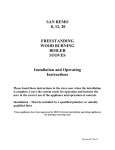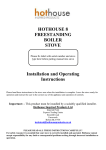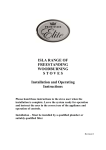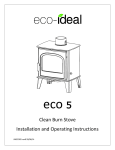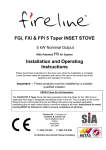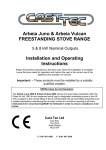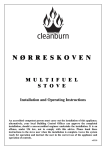Download San Remo Stoves Maxi Operating instructions
Transcript
SAN REMO 8, 12, 20, Maxi FREESTANDING WOOD BURNING BOILER STOVES Installation and Operating Instructions Please hand these instructions to the stove user when the installation is complete. Leave the system ready for operation and instruct the user in the correct use of the appliance and operation of controls. Installation – Must be installed by a qualified plumber or suitably qualified fitter Revised 11-07-11 Technical Specifications. Main Dimensions San Remo 8 San Remo12 San Remo 20 San Remo Maxi A B C D E F G H J K L M N O 705 780 765 790 510 560 635 630 520 580 640 630 150 170 90 115 260 280 320 315 420 460 500 630 135 140 150 165 70 75 80 80 6” 6” 6” 6” 550 615 605 625 315 315 340 335 320 345 390 380 327 355 300 320 1” 1.5” 1.5” 1.5” Technical Specifications (Wood) San Remo 8kW San Remo 12kW San Remo 20kW San Remo Maxi Boiler Boiler Boiler Boiler Total Heat Output kW 8.4 13.0 20.9 27.1 Output to Water kW 5.4 8.2 11.8 15.2 Output to room kW 3.0 4.8 9.1 11.9 Efficiency % 77.7 76.2 73.3 72.1 CO Emission (@13% O2) % 0.38 0.39 0.89 0.9 Flue Gas Temp °C 270 320 370 425 Flue Gas Mass Flow g/s 7.2 9.8 12.9 16.6 Refuel Period hr 1 1 1 1 Safe Distance to Combustibles -Sides mm 100 100 100 100 Safe Distance to Combustibles -Back mm 200 200 200 200 Flue Outlet Size Inch 6” 6” 6” 6” Product Weight (Packed) kg 144 172 200 227 Maximum boiler operating Pressure bar 1.4 1.4 1.4 1.4 Revised 11-07-11 Assembly Instructions PLEASE READ THESE INSTRUCTIONS CAREFULLY It is strongly recommended that this stove is fitted to your heating system by a knowledgeable, experienced and suitably qualified (Hetas or equivalent) plumber or Heating Engineer with experience in fitting boiler stoves. San Remo Stoves cannot accept responsibility for any fault arising through incorrect installation. Your San Remo stove comes packed in a plywood crate Carefully remove the steel straps and lift off the upper crate Remove the plastic bag and, upon opening the door, remove the two boxes containing all the contents and remove contents as shown Revised 11-07-11 1. Remove stove from pallet and carefully tip it over onto it’s back. 2. Ensure legs and fixings are present as shown. 3. Ensure the tapped holes, on the base, are free from obstruction. Use a sharp screwdriver to remove any fire cement. Secure the legs and fixings using the screws and washers provided, two screws and two washers per leg. Revised 11-07-11 1. Fit the Flue Collar using the 4-M6 set screws and washers supplied. Screw The M6 nuts on the M6 screws all the way to the end. Then put the washer over the screw/nut assembly and secure the collar to the lid/back as desired. The flue collar is shown below fixed to the top of the stove. If a back flue outlet is required then remove the blanking plate from the back and fit the collar in its place. Refit the blanking plate to the top of the stove. 2. To fit the Baffle: Insert the baffle as shown below with the chamfers to the bottom. Slide the baffle up behind the Side fins and sit it into place as shown below right. The bottom of the baffle sits on the bottom bracket while the top of the baffle sits on the turbo bar. Revised 11-07-11 List of Components Door Handle Airwash Control Handle Airwash assembly Primary Air Caps Riddling Handle Ash Pan Ash Pan Tool Coal Catcher Baffle Plate Legs Leg Height Screws M8 Leg Screws M8 Leg Washers M8 Flue Collar Flue Collar Screws M6 Flue Collar Nuts M6 Flue Collar Washers M6 Grate Surround LH Grate Surround RH Riddle Grate Outer Grate Grate Seat Glove Repair paint Operator manual Warranty Registration Card 1 1 1 2 1 1 1 1 1 4 4 8 8 1 4 4 4 1 1 1 1 1 1 1 1 1 Revised 11-07-11 Installation Instructions READ THESE INSTRUCTIONS CAREFULLY BEFORE INSTALLATION These instructions cover the basic principles to ensure satisfactory installation of the stove, although detail may need slight modification to suit particular local site conditions. In all cases the installation must comply with National and European Building Regulations, Local Authority Byelaws and other specifications or regulations as they affect the installation of the stove. Health and Safety Precautions Handling Adequate facilities must be available for unloading and site handling. Fire Cement Some types of fire cement are caustic and should not be allowed to come into contact with the skin. In case of contact, wash immediately with plenty of water. Asbestos This stove contains no asbestos. If there is a possibility of disturbing any asbestos in the course of installation then please seek specialist guidance and use appropriate protective equipment. Metal Parts When installing or servicing this stove, care should be taken to avoid the possibility of personal injury. Please note: Any white deposits on the stove joints are caused by humidity reacting with the joint sealant. These deposits may be brushed off and, if necessary, blackened with a proprietary stove polish. Important Warning This stove must not be installed into a chimney that serves any other heating appliance. No purpose provided ventilation is required for stoves rated under 5KW. For each KW above 5KW, 550 sq mm of fixed ventilation is required – i.e. a stove rated at 8KW would require 3 x 550 sq mm = 1650 sq mm of fixed ventilation. If more than one appliance is installed in the same room, the ventilation requirements for each appliance must be added together. There must not be an extractor fan fitted in the same room as the stove as this can cause the stove to emit fumes into the room. Installation Thermostat We recommend that a thermostat control is fitted to your boiler which is used to automatically regulate the water output temperature and prevent water overheating in the boiler. The thermostat must be fitted as per the manufacturer’s instructions which are included with the thermostat. Chimney The chimney height and the position of the chimney terminal should conform to Building Regulations. Check that the chimney is in good condition, dry, free from cracks and obstructions. The diameter of the flue should not be less than 125mm and not more than 200mm. If any of these requirements are not met, the chimney should be lined by a suitable method. The chimney must be swept before connection to the stove. Revised 11-07-11 Where the chimney is believed to have previously served an open fire installation, it is possible that the higher flue gas temperature from the stove may loosen deposits that were previously firmly adhered, with the consequent risk of flue blockage. It is therefore recommended that the chimney be swept a second time within a month of regular use after installation. If you have any doubts about the suitability of your chimney, consult your local dealer/stockist. If there is no existing chimney then either a prefabricated block chimney or a twin-walled insulated stainless steel flue to BS 4543 can be used. These chimneys must be fitted in accordance with the manufacturer’s instructions and Building Regulations. Flue Draught A flue draught of minimum 1.2mm to a maximum 2.5mm water gauge is required for satisfactory appliance performance. The flue draught should be checked under fire at high output and, if it exceeds the recommended maximum, a draught stabiliser must be fitted so that the rate of burning can be controlled and to prevent overfiring. Connection to the Chimney An existing fireplace opening can be bricked up or sealed with a register plate. A short length of flue pipe of a minimum 125mm internal diameter may then be used to connect the stove to the chimney. This flue pipe should conform to Building Regulations. Ensure that the pipe end is no closer than 76mm to the side or rear chimney walls. Ideally, the old fireplace should be filled in so that there is a smooth streamlined entry into the flueway. The length of any horizontal run of flue pipe must not exceed 125mm. It is essential that all connections between the stove and chimney-flue are sealed and made airtight. This appliance is not suitable for installation in a shared flue system. Both the chimney and flue pipe must be accessible for cleaning and if ANY parts of the chimney cannot be reached through the stove (with baffle removed), a soot door must be fitted in a suitable position to enable this to be done. Material Clearances The stove can be recessed in a suitable sized fireplace but a permanent free air gap of at least 150mm must be left around the sides and top and at least 50mm at the back of the stove to obtain maximum heat output and for access to the rear of the stove. All non-combustible walls closer than 400mm to the stove should be at least 75mm thick. In all instances the back wall of the fireplace recess and the hearth should be made of non-combustible material. Allow an apron of at least 300mm at the front of the stove and 150mm on either side. The hearth on which the stove is to be placed should not be less than 125mm thick and should be in accordance with the current building regulations. Care should be taken to level the stove using the adjusting screws in the feet. The appliance shall be installed on a floor with adequate load-bearing capacity. If the existing construction does not meet this prerequisite, suitable measures (e.g. load disturbing plate) should be taken to achieve it. Safety Distances from Combustible Surfaces: See Technical Specifications. Revised 11-07-11 Boiler Connection Revised 11-07-11 It is strongly recommended that this stove is fitted to your heating system by a knowledgeable, experienced and suitably qualified (Hetas or equivalent) plumber or Heating Engineer with experience in fitting boiler stoves. If fitted incorrectly it could result in serious damage to your home heating system. Plumbing should be carried out in accordance with Relevant Building Regulations and safe practices. The manufacturers cannot be held responsible for any losses due to incorrect specification or connection of the heating system. Gravity Circuit Do Not – Under any circumstances connect the stove to a sealed (pressurised) heating system or an unvented HW cylinder Do Not – Link the stove into a heating or hot water system with an existing boiler without the use of suitable equipment such as a neutralizer. When fitting this type of system the neutralizer manufacturer’s instructions must be followed. Do – Fit an open cold feed and header expansion tank with separate cold feed and vent pipes. The cold feed and vent pipes must be unvalved. The open vent pipe should have a diameter of 22mm and rise continuously from the boiler. The gravity circuit should connect to a domestic indirect hot water cylinder of minimum 135lt capacity, using 28mm flow and return pipes, rising continuously from the boiler to the cylinder. Any nominally horizontal runs of gravity pipework should slope upwards at not less than 1:30. The base of the hot water cylinder should be located at least 150mm above the top of the stove. The gravity circuit must not contain any shut off valves and should be fully lagged to minimise heat loss. The pipes should not exceed 7.8 meters (25ft) in length to/from the cylinder. In general, the shorter the run of pipework the less heat loss and the more efficient the water heating. Revised 11-07-11 A heat soak radiator of at least 2kW must be used on the same gravity circuit, positioned above the stove. This is used to dissipate heat when the central heating is switched off or the HW cylinder is fully heated. Link Up: On heating and hot water installations, a semi-pumped system should be used to the central heating system with gravity circulation to the hot water cylinder. For optimum performance of the boiler we recommend that all 4 tappings are used when using separate gravity and pumped heating loops. The flow and return pipes should be taken from diagonally opposite sides of boiler. Injector Tee: If only two tappings are used on a common flow system, they should be taken diagonally opposite and the remaining tappings should be plugged. An injector Tee should be fitted to join the gravity feed and central heating circuits back to the stove, which should be situated as close to the stove as possible. The tee connection encourages the stable flow of water through both circuits and prevents priority being given to the stronger flow, typically the pumped circuit. Pipe Thermostats A HIGH LIMIT thermostat should be fitted to the gravity flow pipe close to the boiler and set at 90°C.This should override any pump control, switching the pump on and dissipating any excess heat around the radiator circuit. To prevent boiler corrosion due to condensation it is necessary to maintain the return water temperature above 45°C. This can be achieved by the use of a LOWLIMIT thermostat on the return pipe from the hot water cylinder, close to the boiler. The thermostat should make on temperature rise, preventing the circulating pump from operating until the gravity circuit is up to temperature. Commissioning and Handover Upon completion of the installation, allow a suitable period of time for any fire cement and mortar to dry out. A small fire may then be lit and checked to ensure the smoke and fumes are taken from the stove up the chimney and emitted safely to atmosphere. Do not run the stove at full output for at least 3 – 4 days. On completion of the installation and commissioning, ensure that the operating instructions and operating tools for the stove are left with the customer. Ensure to advise the customer on the correct use of the appliance with the fuels likely to be used on the stove and warn them to use only the recommended fuels for the stove. Advise the user on what to do should smoke or fumes be emitted from the stove. The user should use a suitable fireguard in the presence of children, aged and/or infirm persons. All connections to the boiler should be checked to ensure there are no leaks during operation and that the flow and return water connections are working properly. The stove should be fired up initially by the Plumber / Heating Engineer to ensure that it is operating safely with the rest of the heating system. Revised 11-07-11 Operating Instructions This appliance is not suitable for use in a shared flue. This appliance should not be operated with the doors open. Aerosol Sprays Do not use an aerosol spray on or near the stove when it is alight. Air Controls This stove has been designed to burn clean and efficient. If used correctly this stove will burn far more efficiently than normal with the obvious notable features of CLEAN GLASS. Never clean glass when stove is hot. Always use stove glass cleaner which is available from your stove retailer. However, for this product to work properly it must be used correctly. It is essential that the stove has an adequate air supply for combustion and ventilation. The primary and secondary air inlets must be kept clear from obstruction. Note: The secondary air control is open when pushed to the right. Warning! This appliance will be hot when In operation and due care should be taken When operating the controls. Revised 11-07-11 Air Controls Primary Air Primary air is controlled via the two rotary air controls on the bottom of the door. This provides a conventional air draught to the bed of the fire. The primary air intakes can be adjusted to give the best possible results when burning different fuels. Secondary Air The cast iron stove is fitted with a sophisticated “air wash” system. This secondary air supply to the stove is controlled through a slider assembly located at the top of the stove. Multifuel Grate Your San Remo Stove is fitted with a rotary style grate, which is operated from the front of the stove via a riddle rod. Use the “Hook” end of tool to operate the riddling system. This rotary grate is located in the centre of a cast iron flat bed with suitable air slots that assist the burning of most fuels. It is important to use the rotary grate to de-ash regularly, to ensure that the primary airflow is not impeded, as a build-up of ash can damage the cast iron bed. Ashpan It is essential that you empty the ashpan regularly. Use the “T” end of tool to lift the ashpan out of the stove. Notes on Wood burning With a full load of wood, the stove will need to be refuelled approximately every 1.5 hours. Wood can be stacked higher in the stove than solid mineral fuel but care must be taken that logs do not touch the baffle. Wood burns most efficiently with the primary air controls closed and the secondary control partially open. Moving the secondary control will control the burn rate of the stove. Note – primary and secondary air is needed to light the stove, see section entitled ‘Lighting the Stove’. Wood burns best on a bed of ash and it is therefore only necessary to remove surplus ash from the stove occasionally. Burn only dry, well-seasoned wood, which should have been cut, split and stacked for at least 12 months, with free air movement around the sides of the stack to enable it to dry out. Burning wet or unseasoned wood will create tar deposits in the stove and chimney and will not produce a satisfactory heat output. Do not use liquid fuels in this appliance. Size of Fuel Log Length Maximum Log Lengths San Remo 8 Boiler Stove San Remo 12 Boiler Stove San Remo 20 Boiler Stove San Remo Maxi Boiler Stove 350mm 390mm 430mm 430mm + Revised 11-07-11 Lighting the Stove We recommend that you have two or three small fires before you operate your stove to its maximum heat output. This is to allow the paint to cure in steadily and to give a long service life of the paint finish. During this curing in process you may notice an unpleasant smell. It is nontoxic, but for your comfort we would suggest that during this period you leave all doors and windows open. Ensure the Primary and secondary air controls are fully open and place some dry paper or firelighters on the grate. Then place a handful of dry kindling on top. Light the fire at the base leaving the primary and secondary air open. Allow the fuel to reach a steady glow (approximately ten minutes) and then add a little more fuel (approximately two or three small logs). Once you have a good fire established across the grate bed, further fuel can be added as required and the primary air controls can be shut completely. Refuelling It is best to refuel little and often, rather than in large pieces. When possible refuel the stove before the bed has gone too low. Open the primary air controls by about two turns and add the fuel. Allow the fuel to burn for a few minutes until the fire is well established before closing the primary air once again. This refuelling procedure will ensure that smoke emission is kept to a minimum. Shutting Down In order to shut down the stove, close the primary air controls, then close the secondary air slider by moving the handle all the way to the left. If the controls are left in this position, the fire will be starved of air and will go out. If you want to revive the fire it is recommended that the primary air controls are open first, and then open the secondary air slider. Please note that the stove cannot be shutdown in this manner when the secondary air stop is fitted as this would produce smoke. Warning! - The stove will remain hot for a considerable time after the fire has been extinguished. Notes: Warning! - Petroleum coke fuels or household waste must not be burnt on this appliance. Should any difficulties arise over fuel quality or suitability, consult your local approved coal merchant. Revised 11-07-11 Safety Notes for your guidance FIRES CAN BE DANGEROUS – Always use a fireguard in the presence of children, the elderly or the infirm. DO NOT OVERFIRE – it is possible to fire the stove beyond its design capacity, this could damage the stove, so watch for signs of overfiring – if any part of the stove starts to glow red, the fire is in an overfire situation and the controls should be adjusted accordingly. Never leave the stove unattended for long periods without first adjusting the controls to a safe setting – careful air supply control should be exercised at all times. Any unauthorised modifications of this appliance will render the guarantee null and void and could be potentially dangerous. Replacement parts should only be sourced from San Remo approved dealers WARNING – FUME EMISSION Properly installed and operated, this appliance will not emit fumes. Occasional fumes from deashing and refuelling may occur. Persistent fume emission must not be tolerated. If fume emission does persist, then the following immediate action should be taken: 1. 2. 3. 4. Open doors and windows to ventilate room Let the fire out, or eject and safely dispose of fuel from the appliance. Check for flue chimney blockage and clean if required. Do not attempt to re-light the fire until the cause has been identified and corrected. If necessary, seek professional advice. Important! – Do not fit an extractor fan in the same room as this appliance. IN THE EVENT OF A CHIMNEY FIRE • Raise the alarm to let others in the house know. • Call the Fire Brigade • Reduce the appliance-burning rate by closing all air controls. • Move furniture and rugs away from the fireplace and remove any nearby ornaments. • Place a fireguard or spark guard in front of the stove. • Feel the chimneybreast for sign of excessive heat. If the wall is becoming hot, move the furniture away. Ensure that the Fire Brigade can gain access to your roof space in order to check this area for signs of fire spread. Revised 11-07-11 Frequently Asked Questions 1 Do stoves require a chimney? All of our multi fuel and wood burning stoves require a suitable chimney or professionally installed flue system. 2 How do I clean the chimney? You will require a chimney sweep to clean the chimney. It is best to provide a dedicated chimney cleaning access door when installing the flue of the stove. 3 Who should install my stove? San Remo want you to enjoy the maximum performance from your Stove products. To ensure this, it is essential that they are installed correctly. We strongly recommend that your San Remo Stove products are installed by a qualified plumber or suitably qualified person. 4 How do I regulate the heat output? Each stove will have spin valves, which will allow you to easily regulate the heat output. 5 What warranty policy do I get? San Remo Stoves will replace, free of charge, any working part that fails (under normal operating conditions) within 12 months of purchase. Consumables such as glass or stove rope are not guaranteed. A call out charge will apply if our engineer attends any stove problem that is not related to product failure. 6 Where can I get spare parts? Your local San Remo Stove retailer will be pleased to supply spare parts and to provide any other information you require. 7 Can the doors be left open while burning? For safety and heat efficiency the doors should remain closed at all times. 8 Why is the stove smoking when lit? A smoking stove can be caused by a flue with back draught problems. A qualified fitter should complete a smoke test prior to fitting the stove to ascertain the integrity of the flue. 9 Why should I “Run in” my stove? To begin, light a series of small fires over a period of a few days to allow the paint finish to cure. The stove is finished with a heat resistant paint and this can be cleaned with a soft brush. Do not clean whilst the stove is hot; wait until it has cooled down. The finish can be renovated with proprietary stove paint If the stove is not “run in” correctly, this may cause the paint to discolour and flake. 10 What is Over Firing? Your stove should never be used in a manner to cause over firing. Over firing can be caused by over loading the stove with fuel, and with primary controls open. If any part of stove glows "red" your stove is over firing and your draught control should be adjusted to restrict airflow to stove. Over firing can cause permanent damage to the appliance which is not covered by warranty. San Remo Stoves 30 – 60 Hawthorn Road Western Industrial Estate Dublin 12 Ireland Revised 11-07-11
















